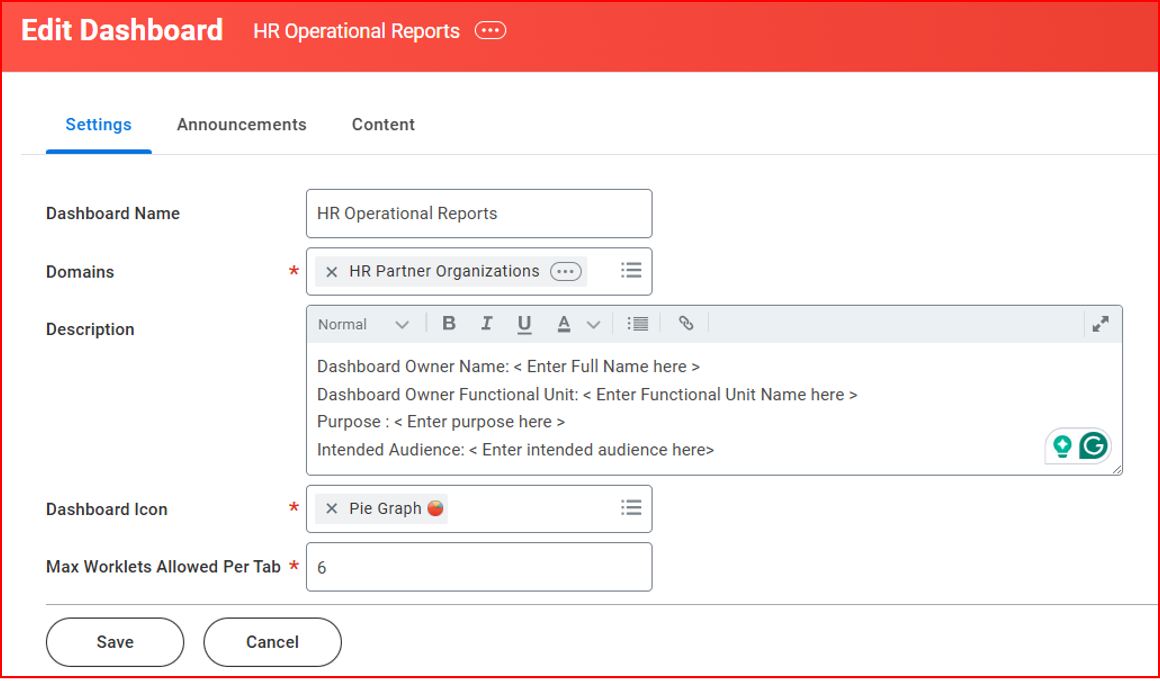Intended Audience and Contact Information
| Contact | Chief Data Officer, Office of the CIO |
|---|---|
| Intended audience: | Internal UBC |
| UDM Domain | Reporting |
| Report Standard ID | DGR005 |
Definition
Workday Dashboard Metadata is the data that needs to be collected when creating a Dashboard in Workday.
A Dashboard is a visual display of key information presented in an organized, clear, and straightforward format. It provides a quick overview of important metrics, key performance indicators (KPIs), and other relevant data that stakeholders need to view and understand at a glance in order to make informed decisions.
Purpose
The purpose of this standard is to achieve consistency in metadata elements for Workday Dashboard Metadata. This standard is to be adhered to at all times. Exceptions, if any, are listed in the Dispensation section.
Standard
All Dashboards are required to capture the following metadata with the prescribed rules:
|
Metadata |
Description |
Format |
Requirement |
|---|---|---|---|
|
Dashboard Name
|
The title used to refer to the Dashboard. |
Refer to Dashboard Name Standard section |
Required |
|
Dashboard Description |
The business needs or objectives for the Dashboard, point of contact and the intended audience of the Dashboard. |
Refer to Dashboard Description Standard section |
Required |
The following rules are to be used when for naming a Dashboard:
| Item | Guideline | ||||||
|---|---|---|---|---|---|---|---|
|
Title case |
Use title case i.e., use capital letters for the principal words; do not capitalize prepositions, articles, or conjunctions. |
||||||
|
Length |
As much as possible, keep the length of the dashboard name limited to allow it to be fully visible on the end use's screen. |
||||||
|
Abbreviations |
Avoid using abbreviations unless it is institutionally common practice to abbreviate a word or phrase. Longer, more detailed names can be very useful in communicating the purpose of a Dashboard to all users in different functional areas.
|
||||||
|
Be clear, specific and consistent |
Avoid general terms such as "Expense Dashboard V1" or "Expense Dashboard V2". Use a specific name – for this example, the name should be updated that explains the differences between V1 and V2. The Dashboard name should clearly state the purpose of the Dashboard. Use a descriptive name to give the user an idea about what the Dashboard provides. This also helps eliminate Dashboard with the same name. Think about a consistent naming format that works for you and your team, so you can locate them quickly. |
||||||
|
Duplication |
Avoid duplicating the same name for a different Dashboard. Each Dashboard must have a unique name. |
||||||
|
Allowed Characters |
See Allowed Characters for System Interoperability Data Standard. |
The information provided within the Dashboard description will help the support team and any other user of the Dashboard to quickly identify and understand what it is. The description should be captured next to the "Description" field. Below are the metadata to be captured in the 'Description' field:
| Description Metadata | Definition |
|---|---|
| Point of Contact Name | The name of the individual that would be able to respond to any related inquiries for the Dashboard. |
| Point of Contact Functional Unit | The name of the functional unit the point of contact belongs to. |
| Purpose | The business need or objective of the Dashboard, i.e. why is the Dashboard created. |
| Intended Audience | The end-users of the Dashboard. |
Enter the "Description Metadata" as shown in the screenshot below:

Compliance
This standard must be complied through every stage of Dashboard development and maintenance with the exception of any dispensations (see Dispensation section).
Dispensation
None
Related Documents
None